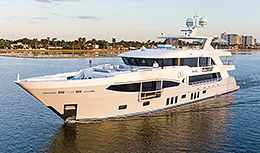- Alaskan Yachts
- Azimut Yachts
- Back Cove Yachts
- Beneteau Yachts
- Benetti Superyachts
- Bertram Yachts
- Boston Whaler
- Broward Yachts
- Buddy Davis Sportfish
- Burger Yachts
- Cabo Yachts
- Catamarans
- Carver Motoryachts
- Center Console
- Chris-Craft Yachts
- Cruisers Yachts
- DeFever Trawlers
- Dufour Sailboats
- Fairline Yachts
- Feadship Yachts
- Ferretti Yachts
- Formula Yachts
- Fountaine Pajot Cats
- Grady-White
- Grand Banks Trawlers
- Hargrave Yachts
- Hatteras Yachts
- Hinckley Picnic Boats
- Horizon Yachts
- Hydra-Sports
- Intrepid Boats
- Jarrett Bay Sportfish
- Jeanneau Yachts
- Kadey-Krogen Trawlers
- Lazzara Yachts
- Lekker Boats
- Luhrs Sportfish
- Marlow Yachts
- Maritimo Yachts
- Marquis Yachts
- Mazu Yachts
- McKinna Motoryachts
- Meridian Yachts
- Midnight Express
- MJM Yachts
- Mochi Craft
- Neptunus Motoryachts
- Nordhavn Trawlers
- Nordic Tugs
- Numarine Yachts
- Ocean Alexander Yachts
- Ocean King
- Offshore Yachts
- Outer Reef
- Oyster Sailing Yachts
- Pacific Mariner Yachts
- Palmer Johnson Yachts
The Various Costs of Owning a Boat or Yacht
Prepare for your next boat purchase.
Updated: November 18, 2020
About 95% of owners have boats 26 feet or less at an average cost of $18,000, according to the National Marine Manufacturers Association, and more than 80% of those buyers shelled out for used or brokerage boats. But buying a boat or yacht is just the start. Bentley Collins of Sabre Yachts says to budget 10% of the boat’s value annually to cover expenses. And then there are the extras.
About 5% of the world’s ultra-high-net-worth individuals own a yacht. A 180′ superyacht costs $4.75 million annually to maintain and run. Kitty McGowan of the US Superyacht Association says that among the costs, you need to budget $400,000 for fuel, $350,000 for dockage, $240,000 for vessel insurance, $1 million for maintenance and repairs, and $1.4 million for crew salaries. We broke down how much it costs to own a boat so you can prepare for your next purchase.
Oil And Gas

Fuel prices can make a big dent in your budget if you’re relying on an engine rather than sails. As a point of reference, it costs about $400 to fill the 80-gallon tank of a 27′ Chaparral with a single-engine. A Tiara 4500 Sovran — a heavy-duty powerboat that is considered fuel-efficient — costs about $1,750 to fill a 350-gallon tank. An oil change can run you about $300.
Title, Registration, And Insurance

The amount you pay for title, registration, and insurance depends on the state and the boat’s size. For instance, the title fee for a new boat in Oregon is $75. Registration is about $8 per foot. In Connecticut, registration runs about $105 for a 26-foot fiberglass boat. Like a car, you need insurance. Figure out the cost at about 1.5% of the insured value of the boat, which covers the boat but not anything silly you might do — such as running into a sand bar.
Maintenance

Cut costs by washing your boat with fresh water after each use. Even then, you may need to repaint the bottom of the boat with anti-fouling paint once a year. If you have a sailboat, plan on replacing the sails every three to five years. With powerboats, you’ll need to check and service the engines more frequently. All of these extras add up — from about $300 per year for cleaners and soaps to several hundred dollars on waxing the hull and treating fabric.
Winter Storage

Storage, which includes hauling the boat, dry-docking it, shrink-wrapping it, and blocking it (so it doesn’t move), costs about $3,000 for a 38′ boat in Connecticut and about $1,500 in Maine. Dockage can also run you a couple hundred to a thousand dollars per month if you’re not on the waterfront.
Safety

High-quality life jackets can run about $70 each. A package with a safety gear bag, a Freon horn, a fire extinguisher, a visual distress signal kit as well as dock lines costs $170. Add to electronics — such as a GPS chart plotter and a radio system — items that easily tack on an extra $20,000 per boat.
Toys And Tenders

Toys may not be a priority on your yacht, but jet skis, seabobs, kayaks, canoes, tenders, paddleboards, and inflatables cost an extra few thousand dollars each. A seabob costs about $1,000. And if you have kids, the RedShark 10-man Towable 17′ floater will bring hours of fun attached to the back of your boat for about $1,600.
Most Cost-Efficient Boat

Trawlers are like sailboats but without the mast. They come with a cabin, air conditioning, and heating but not much deck space. They travel at about 8 knots per hour and cost about $160,000 to buy used. They are fuel-efficient, using about 50 to 100 gallons of fuel a year. Trawlers are perfect for families and liveaboards.
If you’re in the market to buy a new or used boat or yacht, consider all of the costs involved. From cleaning to storage, there’s always a fee — yet if that’s the cost of pure bliss on the water, then so be it. Contact Denison Yachting to find your next new or used boat.
Looking for more details?
Receive the complete Costs Of Ownership Guide including:
- • Offsetting Expenses With Charter
- • Superyacht Financing
- • Budget Development + More

Source: Washington Post. Bloomberg Rankings examined the costs associated with buying and owning a boat. Costs vary and not all listed apply to everyone.






